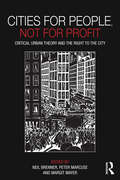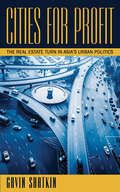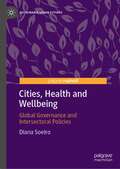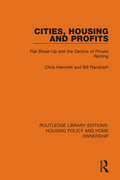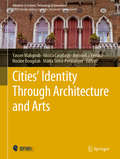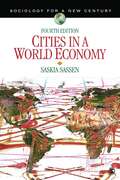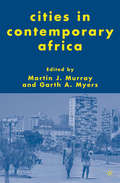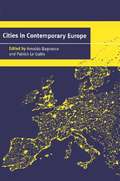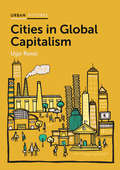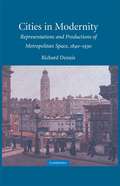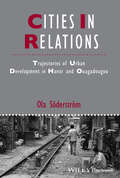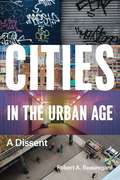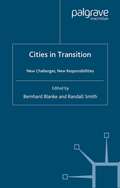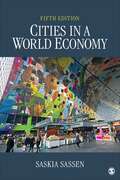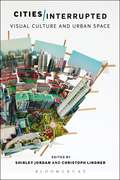- Table View
- List View
Cities for People, Not for Profit: Critical Urban Theory and the Right to the City
by Neil Brenner Peter Marcuse Margit MayerThe worldwide financial crisis has sent shock-waves of accelerated economic restructuring, regulatory reorganization and sociopolitical conflict through cities around the world. It has also given new impetus to the struggles of urban social movements emphasizing the injustice, destructiveness and unsustainability of capitalist forms of urbanization. This book contributes analyses intended to be useful for efforts to roll back contemporary profit-based forms of urbanization, and to promote alternative, radically democratic and sustainable forms of urbanism. The contributors provide cutting-edge analyses of contemporary urban restructuring, including the issues of neoliberalization, gentrification, colonization, "creative" cities, architecture and political power, sub-prime mortgage foreclosures and the ongoing struggles of "right to the city" movements. At the same time, the book explores the diverse interpretive frameworks – critical and otherwise – that are currently being used in academic discourse, in political struggles, and in everyday life to decipher contemporary urban transformations and contestations. The slogan, "cities for people, not for profit," sets into stark relief what the contributors view as a central political question involved in efforts, at once theoretical and practical, to address the global urban crises of our time. Drawing upon European and North American scholarship in sociology, politics, geography, urban planning and urban design, the book provides useful insights and perspectives for citizens, activists and intellectuals interested in exploring alternatives to contemporary forms of capitalist urbanization.
Cities for People, Not for Profit: Critical Urban Theory and the Right to the City
by Neil Brenner Peter Marcuse Margit MayerThe worldwide financial crisis has sent shock-waves of accelerated economic restructuring, regulatory reorganization and sociopolitical conflict through cities around the world. It has also given new impetus to the struggles of urban social movements emphasizing the injustice, destructiveness and unsustainability of capitalist forms of urbanization. This book contributes analyses intended to be useful for efforts to roll back contemporary profit-based forms of urbanization, and to promote alternative, radically democratic and sustainable forms of urbanism. The contributors provide cutting-edge analyses of contemporary urban restructuring, including the issues of neoliberalization, gentrification, colonization, "creative" cities, architecture and political power, sub-prime mortgage foreclosures and the ongoing struggles of "right to the city" movements. At the same time, the book explores the diverse interpretive frameworks – critical and otherwise – that are currently being used in academic discourse, in political struggles, and in everyday life to decipher contemporary urban transformations and contestations. The slogan, "cities for people, not for profit," sets into stark relief what the contributors view as a central political question involved in efforts, at once theoretical and practical, to address the global urban crises of our time. Drawing upon European and North American scholarship in sociology, politics, geography, urban planning and urban design, the book provides useful insights and perspectives for citizens, activists and intellectuals interested in exploring alternatives to contemporary forms of capitalist urbanization.
Cities for Profit: The Real Estate Turn in Asia’s Urban Politics
by Gavin ShatkinCities for Profit examines the phenomenon of urban real estate megaprojects in Asia—massive, privately built planned urban developments that have captured the imagination of politicians, policymakers, and citizens across the region. These controversial projects, embraced by elites, occasion massive displacement and have extensive social and economic impacts. Gavin Shatkin finds commonalities and similarities in dozens of such projects in Jakarta, Kolkata, and Chongqing. Shatkin is at the vanguard of urban studies in his focus on real estate. Just as cities are increasingly defined and remapped according to the value of the land under their residents’ feet, the lives of city dwellers are shaped and constrained by their ability to keep up with rising costs of urban life. Scholars and policy and planning professionals alike will benefit from Shatkin’s comprehensive research. Cities for Profit contains insights from more than 150 interviews, site visits to projects, and data from government and nongovernmental organization reports and data, urban plans, architectural renderings, annual reports and promotional materials of developers, and newspaper and other media accounts.
Cities, Health and Wellbeing: Global Governance and Intersectoral Policies (Sustainable Urban Futures)
by Diana SoeiroOn 25 September 2015, the United Nations General Assembly unanimously adopted Resolution 70/1, “Transforming our World: the 2030 Agenda for Sustainable Development”. Also known as 2030 Agenda, the document lays out 17 Sustainable Development Goals (SDGs) in the realm of ecology, society and economy. The current book focuses on three of these goals: SDG 16: Peace, Justice and Strong Institutions; SDG 3: Health and Wellbeing; SDG 11: Cities and Sustainable Communities. It is critical that interdisciplinary approaches go one step further and translate more effectively into intersectoral policies. This is particularly vital when it comes to urban planning and health. This book address the key question: In the context of a growing influence of European Union policies at a national level, can SDGs simultaneously contribute to harmonising sectoral policies and promoting intersectoral policies? Claiming a growing convergence between health and spatial planning, the main goal of the book is to formulate an answer to the following question: how can policymakers translate the SDGs effectively into public policies in order to improve cities, health and wellbeing?
Cities, Housing and Profits: Flat Break-Up and the Decline of Private Renting
by Chris Hamnett Bill RandolphOriginally published in 1988, this book documents and explains the emergence of flat ‘break-ups’ – the sale of individual owner occupation of blocks of flats which were previously privately rented and which played a major role in the transformation of the private housing market in London since the 1960s. The book shows that the flat break-up market in London was not a unique phenomenon but one of the most geographically concentrated manifestations of the trend for sales from private renting to owner occupation which has been established in the UK since the 1920s. The interrelationship between the causes of the decline of the privately rented sector in Britain and the features specific to the flat market comprises the second theme of the book.
Cities, Housing and Profits: Flat Break-Up and the Decline of Private Renting
by Chris Hamnett Bill RandolphOriginally published in 1988, this book documents and explains the emergence of flat ‘break-ups’ – the sale of individual owner occupation of blocks of flats which were previously privately rented and which played a major role in the transformation of the private housing market in London since the 1960s. The book shows that the flat break-up market in London was not a unique phenomenon but one of the most geographically concentrated manifestations of the trend for sales from private renting to owner occupation which has been established in the UK since the 1920s. The interrelationship between the causes of the decline of the privately rented sector in Britain and the features specific to the flat market comprises the second theme of the book.
Cities' Identity Through Architecture and Arts: Proceedings Of The International Conference On Cities' Identity Through Architecture And Arts (citaa 2017), May 11-13, 2017, Cairo, Egypt (Advances in Science, Technology & Innovation)
by Yasser Mahgoub Nicola Cavalagli Antonella Versaci Hocine Bougdah Marta Serra-PermanyerThis book covers a broad range of topics relating to architecture and urban design, such as the conservation of cities’ culture and identity through design and planning processes, various ideologies and approaches to achieving more sustainable cities while retaining their identities, and strategies to help cities advertise themselves on the global market.Every city has its own unique identity, which is revealed through its physical and visual form. It is seen through the eyes of its inhabitants and visitors, and is where their collective memories are shaped. In turn, these factors affect tourism, education, culture & economic prosperity, in addition to other aspects, making a city’s identity one of its main assets.Cities’ identities are constructed and developed over time and are constantly evolving physically, culturally and sociologically. This book explains how architecture and the arts can embody the historical, cultural and economic characteristics of the city. It also demonstrates how cities’ memories play a vital role in preserving their physical and nonphysical heritage. Furthermore, it examines the transformation of cities and urban cultures, and investigates the various new approaches developed in contemporary arts and architecture.Given its scope, the book is a valuable resource for a variety of readers, including students, educators, researchers and practitioners in the fields of city planning, urban design, architecture and the arts.
Cities in a World Economy (PDF)
by Saskia SassenThe Fourth Edition of Cities in a World Economy shows how certain characteristics of our turn-of-the-millennium flows of money, information and people have led to the emergence of a new social formation: global cities. These developments give new meaning to such fixtures of urban sociology as the centrality of place and the importance of geography in our social world.
Cities in Contemporary Africa
by M. Murray G. MyersThis book explains how and why cities on the African continent have grown at such a rapid pace, how municipal authorities have tried to cope with this massive influx of people, and how long-time urban residents and newcomers interact, negotiate, and struggle over access to limited resources.
Cities in Contemporary Europe (PDF)
by Arnaldo Bagnasco Patrick Le Gale`sEuropean cities are at the centre of social, political and economic changes in Western Europe. This book proposes a new research agenda in urban sociology and politics applying primarily to European cities, in particular those that together make up the urban structure of Europe: a fabric of older cities of over 100,000 inhabitants, regional capitals and smaller state capitals. The contributors develop an analytical framework which views cities as local societies, and as collective actors and sites for modes of governance. The book examines the economics of cities, their social structures, and the modes and processes of governance. Each chapter comprises a comparison across several countries and critically examines the book’s central theoretical perspective. This is not a book about the making of a Europe of cities but rather about how some cities can take advantage of their changing global and European environment.
Cities in Global Capitalism
by Ugo RossiIn what ways are cities central to the evolution of contemporary global capitalism? And in what ways is global capitalism forged by the urban experience? This book provides a response to these questions, exploring the multifaceted dimensions of the city-capitalism nexus. Drawing on a wide range of conceptual approaches, including political economy, neo-institutionalism and radical political theory, this insightful book examines the complex relationships between contemporary capitalist cities and key forces of our times, such as globalization and neoliberalism. Taking a truly global perspective, Ugo Rossi offers a comparative analysis of the ways in which urban economies and societies reflect and at the same time act as engines of global capitalism. Ultimately, this book shows how over the past three decades capitalism has shifted a gear – no longer merely incorporating key aspects of society into its system, but encompassing everything, including life itself – and illustrates how cities play a central role within this life-oriented construction of global capitalism.
Cities in Global Capitalism
by Ugo RossiIn what ways are cities central to the evolution of contemporary global capitalism? And in what ways is global capitalism forged by the urban experience? This book provides a response to these questions, exploring the multifaceted dimensions of the city-capitalism nexus. Drawing on a wide range of conceptual approaches, including political economy, neo-institutionalism and radical political theory, this insightful book examines the complex relationships between contemporary capitalist cities and key forces of our times, such as globalization and neoliberalism. Taking a truly global perspective, Ugo Rossi offers a comparative analysis of the ways in which urban economies and societies reflect and at the same time act as engines of global capitalism. Ultimately, this book shows how over the past three decades capitalism has shifted a gear – no longer merely incorporating key aspects of society into its system, but encompassing everything, including life itself – and illustrates how cities play a central role within this life-oriented construction of global capitalism.
Cities In Modernity: Representations And Productions Of Metropolitan Space, 1840-1930 (PDF)
by Richard DennisWhat made cities 'modern' in the nineteenth and early twentieth centuries? Cities in Modernity explores connections between culture, economy and built environment in cities of this period, drawing its evidence principally from London, New York and Toronto. The book discusses both the cultural experience of modernity and the material modernization of cities, placing special emphasis on their historical geographies, on the production, representation and use of urban space. The opening chapters present new ways of seeing cities in political and religious discourse, social survey, mapping, art and literature. The book then concentrates on new kinds of public and private spaces, such as apartment buildings, office blocks and department stores, and the networks of communication between them. An important theme throughout is the gendered experience of the new types of environment. The book will appeal to scholars and students of historical geography, urban history and cultural studies. 9780521468411
Cities in Relations: Trajectories of Urban Development in Hanoi and Ouagadougou (IJURR Studies in Urban and Social Change Book Series)
by Ola SöderströmCities in Relations advances a novel way of thinking about urban transformation by focusing on transnational relations in the least developed countries. Examines the last 20 years of urban development in Hanoi, Vietnam, and in Ouagadougou, Burkina Faso Considers the ways in which a city’s relationships with other places influences its urban development Provides fresh ideas for comparative urban studies that move beyond discussions of economic and policy factors Offers a clear and concise narrative accompanied by more than 45 photos and maps
Cities in Relations: Trajectories of Urban Development in Hanoi and Ouagadougou (IJURR Studies in Urban and Social Change Book Series)
by Ola SöderströmCities in Relations advances a novel way of thinking about urban transformation by focusing on transnational relations in the least developed countries. Examines the last 20 years of urban development in Hanoi, Vietnam, and in Ouagadougou, Burkina Faso Considers the ways in which a city’s relationships with other places influences its urban development Provides fresh ideas for comparative urban studies that move beyond discussions of economic and policy factors Offers a clear and concise narrative accompanied by more than 45 photos and maps
Cities in the Urban Age: A Dissent
by Robert A. BeauregardWe live in a self-proclaimed Urban Age, where we celebrate the city as the source of economic prosperity, a nurturer of social and cultural diversity, and a place primed for democracy. We proclaim the city as the fertile ground from which progress will arise. Without cities, we tell ourselves, human civilization would falter and decay. In Cities in the Urban Age, Robert A. Beauregard argues that this line of thinking is not only hyperbolic—it is too celebratory by half. For Beauregard, the city is a cauldron for four haunting contradictions. First, cities are equally defined by both their wealth and their poverty. Second, cities are simultaneously environmentally destructive and yet promise sustainability. Third, cities encourage rule by political machines and oligarchies, even as they are essentially democratic and at least nominally open to all. And fourth, city life promotes tolerance among disparate groups, even as the friction among them often erupts into violence. Beauregard offers no simple solutions or proposed remedies for these contradictions; indeed, he doesn’t necessarily hold that they need to be resolved, since they are generative of city life. Without these four tensions, cities wouldn’t be cities. Rather, Beauregard argues that only by recognizing these ambiguities and contradictions can we even begin to understand our moral obligations, as well as the clearest paths toward equality, justice, and peace in urban settings.
Cities in the Urban Age: A Dissent
by Robert A. BeauregardWe live in a self-proclaimed Urban Age, where we celebrate the city as the source of economic prosperity, a nurturer of social and cultural diversity, and a place primed for democracy. We proclaim the city as the fertile ground from which progress will arise. Without cities, we tell ourselves, human civilization would falter and decay. In Cities in the Urban Age, Robert A. Beauregard argues that this line of thinking is not only hyperbolic—it is too celebratory by half. For Beauregard, the city is a cauldron for four haunting contradictions. First, cities are equally defined by both their wealth and their poverty. Second, cities are simultaneously environmentally destructive and yet promise sustainability. Third, cities encourage rule by political machines and oligarchies, even as they are essentially democratic and at least nominally open to all. And fourth, city life promotes tolerance among disparate groups, even as the friction among them often erupts into violence. Beauregard offers no simple solutions or proposed remedies for these contradictions; indeed, he doesn’t necessarily hold that they need to be resolved, since they are generative of city life. Without these four tensions, cities wouldn’t be cities. Rather, Beauregard argues that only by recognizing these ambiguities and contradictions can we even begin to understand our moral obligations, as well as the clearest paths toward equality, justice, and peace in urban settings.
Cities in the Urban Age: A Dissent
by Robert A. BeauregardWe live in a self-proclaimed Urban Age, where we celebrate the city as the source of economic prosperity, a nurturer of social and cultural diversity, and a place primed for democracy. We proclaim the city as the fertile ground from which progress will arise. Without cities, we tell ourselves, human civilization would falter and decay. In Cities in the Urban Age, Robert A. Beauregard argues that this line of thinking is not only hyperbolic—it is too celebratory by half. For Beauregard, the city is a cauldron for four haunting contradictions. First, cities are equally defined by both their wealth and their poverty. Second, cities are simultaneously environmentally destructive and yet promise sustainability. Third, cities encourage rule by political machines and oligarchies, even as they are essentially democratic and at least nominally open to all. And fourth, city life promotes tolerance among disparate groups, even as the friction among them often erupts into violence. Beauregard offers no simple solutions or proposed remedies for these contradictions; indeed, he doesn’t necessarily hold that they need to be resolved, since they are generative of city life. Without these four tensions, cities wouldn’t be cities. Rather, Beauregard argues that only by recognizing these ambiguities and contradictions can we even begin to understand our moral obligations, as well as the clearest paths toward equality, justice, and peace in urban settings.
Cities in the Urban Age: A Dissent
by Robert A. BeauregardWe live in a self-proclaimed Urban Age, where we celebrate the city as the source of economic prosperity, a nurturer of social and cultural diversity, and a place primed for democracy. We proclaim the city as the fertile ground from which progress will arise. Without cities, we tell ourselves, human civilization would falter and decay. In Cities in the Urban Age, Robert A. Beauregard argues that this line of thinking is not only hyperbolic—it is too celebratory by half. For Beauregard, the city is a cauldron for four haunting contradictions. First, cities are equally defined by both their wealth and their poverty. Second, cities are simultaneously environmentally destructive and yet promise sustainability. Third, cities encourage rule by political machines and oligarchies, even as they are essentially democratic and at least nominally open to all. And fourth, city life promotes tolerance among disparate groups, even as the friction among them often erupts into violence. Beauregard offers no simple solutions or proposed remedies for these contradictions; indeed, he doesn’t necessarily hold that they need to be resolved, since they are generative of city life. Without these four tensions, cities wouldn’t be cities. Rather, Beauregard argues that only by recognizing these ambiguities and contradictions can we even begin to understand our moral obligations, as well as the clearest paths toward equality, justice, and peace in urban settings.
Cities in the Urban Age: A Dissent
by Robert A. BeauregardWe live in a self-proclaimed Urban Age, where we celebrate the city as the source of economic prosperity, a nurturer of social and cultural diversity, and a place primed for democracy. We proclaim the city as the fertile ground from which progress will arise. Without cities, we tell ourselves, human civilization would falter and decay. In Cities in the Urban Age, Robert A. Beauregard argues that this line of thinking is not only hyperbolic—it is too celebratory by half. For Beauregard, the city is a cauldron for four haunting contradictions. First, cities are equally defined by both their wealth and their poverty. Second, cities are simultaneously environmentally destructive and yet promise sustainability. Third, cities encourage rule by political machines and oligarchies, even as they are essentially democratic and at least nominally open to all. And fourth, city life promotes tolerance among disparate groups, even as the friction among them often erupts into violence. Beauregard offers no simple solutions or proposed remedies for these contradictions; indeed, he doesn’t necessarily hold that they need to be resolved, since they are generative of city life. Without these four tensions, cities wouldn’t be cities. Rather, Beauregard argues that only by recognizing these ambiguities and contradictions can we even begin to understand our moral obligations, as well as the clearest paths toward equality, justice, and peace in urban settings.
Cities in the Urban Age: A Dissent
by Robert A. BeauregardWe live in a self-proclaimed Urban Age, where we celebrate the city as the source of economic prosperity, a nurturer of social and cultural diversity, and a place primed for democracy. We proclaim the city as the fertile ground from which progress will arise. Without cities, we tell ourselves, human civilization would falter and decay. In Cities in the Urban Age, Robert A. Beauregard argues that this line of thinking is not only hyperbolic—it is too celebratory by half. For Beauregard, the city is a cauldron for four haunting contradictions. First, cities are equally defined by both their wealth and their poverty. Second, cities are simultaneously environmentally destructive and yet promise sustainability. Third, cities encourage rule by political machines and oligarchies, even as they are essentially democratic and at least nominally open to all. And fourth, city life promotes tolerance among disparate groups, even as the friction among them often erupts into violence. Beauregard offers no simple solutions or proposed remedies for these contradictions; indeed, he doesn’t necessarily hold that they need to be resolved, since they are generative of city life. Without these four tensions, cities wouldn’t be cities. Rather, Beauregard argues that only by recognizing these ambiguities and contradictions can we even begin to understand our moral obligations, as well as the clearest paths toward equality, justice, and peace in urban settings.
Cities in Transition: New Challenges, New Responsibilities (Anglo-German Foundation)
by Bernhard Blanke Randall SmithThis volume explores a range of current problems faced by cities in Germany and England and reflects on constructive strategies for enhancing the quality of life for the citizens of twenty-first century urban environments. The chapters of the book are based on papers given at a symposium organised by the Universities of Bristol and Hannover in 1997 to celebrate the 50th anniversary of twinning between the cities of Hannover and Bristol.
Cities Interrupted: Visual Culture and Urban Space
by Shirley Jordan Christoph LindnerCities Interrupted explores the potential of visual culture – in the form of photography, film, performance, architecture, urban design, and mixed media – to strategically interrupt processes of globalization in contemporary urban spaces. Looking at cities such as Amsterdam, Beijing, Doha, London, New York, and Paris, the book brings together original essays to reveal how the concept of 'interruption' in global cities enables new understanding of the forms of space, experience, and community that are emerging in today's rapidly transforming urban environments.The idea of 'interruption' addressed in this book refers to deliberate interventions in the spaces and communities of contemporary cities – interventions that seek to disrupt or destabilize the experience of everyday urban life through creative practice. Interruption is used as an analytic and conceptual tool to challenge – and explore alternatives to – the narratives of speed, hyper-mobility, rapid growth, and incessant exchange and flow that have dominated critical thinking on global cities.Bringing art and creative practice into the centre of discussions about the future of cities, alongside discussions of development, design, justice, health, sustainability, technology, and citizenship, this book is essential reading for anyone working at the intersections of a range of urban, cultural and visual fields, including urban studies, urban design and architecture, visual studies, cultural studies, media studies, art history, and social and cultural geography.
Cities Interrupted: Visual Culture and Urban Space
by Shirley Jordan Christoph LindnerCities Interrupted explores the potential of visual culture – in the form of photography, film, performance, architecture, urban design, and mixed media – to strategically interrupt processes of globalization in contemporary urban spaces. Looking at cities such as Amsterdam, Beijing, Doha, London, New York, and Paris, the book brings together original essays to reveal how the concept of 'interruption' in global cities enables new understanding of the forms of space, experience, and community that are emerging in today's rapidly transforming urban environments.The idea of 'interruption' addressed in this book refers to deliberate interventions in the spaces and communities of contemporary cities – interventions that seek to disrupt or destabilize the experience of everyday urban life through creative practice. Interruption is used as an analytic and conceptual tool to challenge – and explore alternatives to – the narratives of speed, hyper-mobility, rapid growth, and incessant exchange and flow that have dominated critical thinking on global cities.Bringing art and creative practice into the centre of discussions about the future of cities, alongside discussions of development, design, justice, health, sustainability, technology, and citizenship, this book is essential reading for anyone working at the intersections of a range of urban, cultural and visual fields, including urban studies, urban design and architecture, visual studies, cultural studies, media studies, art history, and social and cultural geography.
